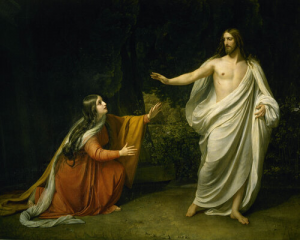 Saint Mary Magdalen
Saint Mary Magdalen
Penitent (First century)
Feast-July 22
“Simon, I have something to say to you.” “Tell me, teacher,” he said. “Two people were in debt to a certain creditor; one owed five hundred days’ wages and the other owed fifty. Since they were unable to repay the debt, he forgave it for both. Which of them will love him more?” Simon said in reply, “The one, I suppose, whose larger debt was forgiven.” He said to him, “You have judged rightly.” (Luke 7:40-43)
This truth is well known to converts. They were lost and were brought back. They know how miserable and grey life was before conversion and how colorful it became after. All because the love of God entered their hearts. St. Mary Magdalen, “from whom seven devils had gone out” is a beautiful and inspiring example of the great love of a convert.
Honored by some as a heroine of the faith she is one of the Twelve and some women who had been cured of evil spirits and infirmities, who travelled with Jesus and helped support his ministry “out of their resources”. She bore witness to His crucifixion and was the first to visit the tomb early in the morning, while it was still dark, and see the stone removed from the entrance. She ran to Simon Peter and the other disciple whom Jesus loved, and told them, “They have taken the Lord from the tomb, and we don’t know where they put him.”
When the disciples returned home, she alone remained outside the tomb weeping. As she wept, she bent over into the tomb and saw two angels in white sitting there, one at the head and one at the feet where the body of Jesus had been. And they said to her, “Woman, why are you weeping?” She said to them, “They have taken my Lord, and I don’t know where they laid him.” When she had said this, she turned around and saw Jesus there, but did not know it was Jesus.
Then when Jesus said to her, “Woman, why are you weeping? Whom are you looking for?” She thought it was the gardener and said to him, “Sir, if you carried him away, tell me where you laid him, and I will take him.” Jesus said to her, “Mary!” She turned and said to him in Hebrew, “Rabbouni,” which means Teacher. (John 20:1-16)
The sinful woman, Mary Magdalen, as described in Luke 7:37-38, who, when she learned that Jesus was in the city “at table in the house of the Pharisee. Bringing an alabaster flask of ointment, she stood behind him at his feet weeping and began to bathe his feet with her tears. Then she wiped them with her hair, kissed them, and anointed them with the ointment,” is, according to Catholic tradition, the same person as Mary Bethany. It happened that, on the eve of His Passion, she once again brought precious ointment, and as His purified and beloved follower, this time poured it on His head, and we may say that the entire House of God is still filled with the fragrance of her anointing. Mary Magdalen stood with Our Lady and Saint John at the foot of the cross, representing the many who have loved much because much has been forgiven them.
In the 13th century, the Archbishop of Genoa, Jacobus de Voragine, wrote about Mary, Martha and Lazarus of Bethany that they were born of right noble parents and descended of the lineage of kings. Their father was named Syro (Cyrus) and their mother Encharia (Eucharis). The siblings possessed 3 places, (1) the castle of Magdalen (Magdalo), which was 2 miles from Nazareth in Galilee (with Sea of Galilee on the east), (2) Bethany town itself, and (3) a great part of Jerusalem, which, all these things they divided among themselves in such a way that Mary had the castle Magdalo, whereof she had her name Magdalen; Lazarus had the part of the city of Jerusalem. He extended all to knighthood. Martha, who was wise, governed nobly her brother’s, her sister’s, and also her own part, Bethany. Martha was recorded to be without husband. She administered to knights, and her servants, and to poor men such necessities as they needed, and ministered and served our Lord, Jesus Christ.
On the other hand, the wealthy and attractive Mary sought love and happiness, giving herself to all the delights of the body.
It was commonly believed that woman caught in adultery, from John chapter 8:1-11, who was brought before Jesus by the scribes and Pharisees to stone “so that they could have some charge to bring against him,” was Mary Magdalen. While this can’t be verified, but knowing that everyone seeks true love, and this true love that can transform a sinner into a saint only comes from God through Jesus.
After the ascension of our Lord, Mary Magdalen and Martha sold their inheritances, and when the faithful were scattered by persecution the family of Bethany found refuge in southern Gaul (south of France). The cave in which St. Mary Magdalen lived for thirty years is still seen, with a chapel on the mountaintop, in which she was caught up daily, like Saint Paul, to visions and revelations of the Lord. When her end drew near, she was borne to a place still marked by a monument, where the holy Bishop Maximin awaited her; and when she had received her Lord, she peacefully fell asleep in death.
References and Excerpts:
[1] H. expressions (anthony Chia), “high.expressions (by Anthony Chia): Were Mary Magdalene and Mary Bethany the same person?,” high.expressions (by Anthony Chia). Accessed: Jul. 04, 2024. [Online]. Available: https://high-expressions.blogspot.com/2011/10/were-mary-magdalene-and-mary-bethany.html
[2] “Saint Mary Magdalen, Penitent.” Accessed: Jul. 04, 2024. [Online]. Available: https://sanctoral.com/en/saints/saint_mary_magdalen.html
[3] “Mary Magdalene: Faith, Courage, and an Empty Tomb,” Beyond These Stone Walls. Accessed: Jul. 04, 2024. [Online]. Available: https://beyondthesestonewalls.com/posts/mary-magdalene-faith-courage-and-an-empty-tomb
[4] “Mary Magdalene,” Wikipedia. Jul. 04, 2024. Accessed: Jul. 04, 2024. [Online]. Available: https://en.wikipedia.org/w/index.php?title=Mary_Magdalene&oldid=1232600018